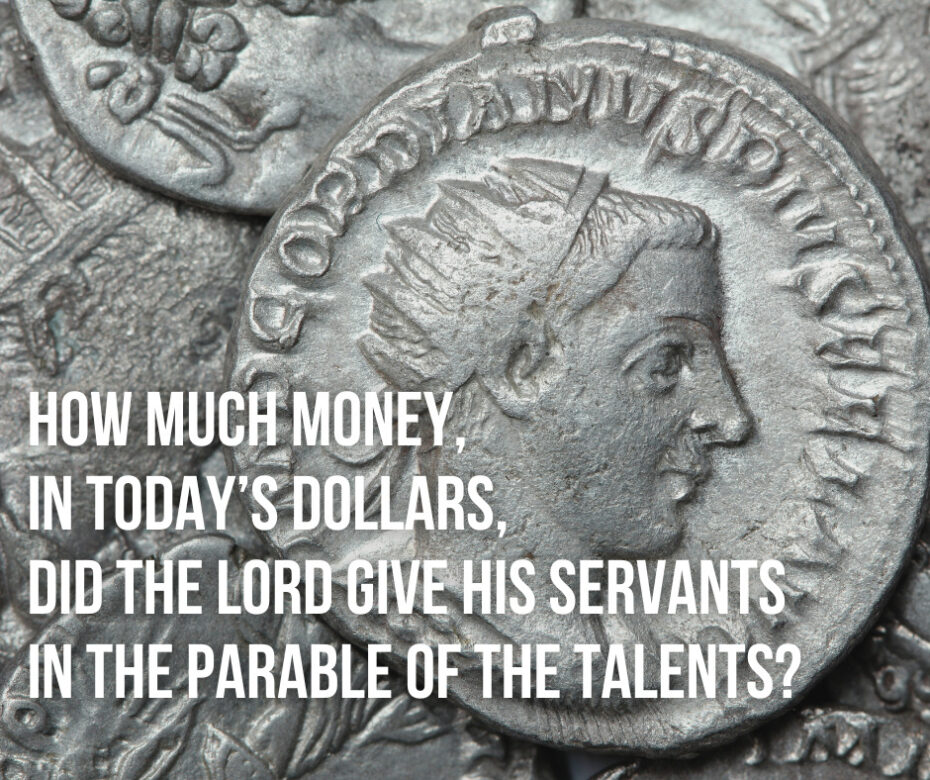I’m scheduled to speak to a group of kids, ages five to twelve, at VBS. I’m speaking on the feeding of the 5,000 in John 6.
I plan to ask them, “When Jesus’ disciples said it would take at least ‘two hundred denarii worth of bread’ to feed this huge crowd, how much money were they talking about? How much money would 200 denarii then be worth today?”
Do you know?
A denarius (the singular of denarii) was a small, solid-silver coin the size of a dime. With the current price of silver, a U.S. dime–the equivalent coin–is worth $1.78. However, there are better ways to compare the buying power
For one thing, buying a low-quality first-century denarius today costs between $80 and $120.i That would mean 200 denarii equate to above $20,000.
Another way of looking at it is that a denarius was a day’s wage for a day laborer at the time of Christ. In today’s dollars, that is around $80. So 200 denarii equate to about $16,000.
The average cost of a loaf of bread today is $2.50 nationwide. So 200 denarii would buy around 6,400 loaves of bread. Since there were 20,000 people to feed–5,000 men plus their wives and children–that would mean one loaf of bread for every 3 people. If that were your whole meal, that would barely be enough to give everyone a little to eat. Imagine a lunch that is 5 slices of bread.
Knowing what a denarius is worth in today’s dollars is important to understanding the miracle.
I often teach on the Parable of the Minas in Luke 19:11-27. Knowing how much money the Lord entrusted to each servant to invest is important.
Again, there are various ways to calculate this.
A mina was worth 100 times a denarius. So a mina would be worth around $8,000 to $10,000 in today’s dollars.
A mina was what a common laborer would make in four months. In today’s America, that is around $10,000.
A mina would buy 100 sheep. At $300-$400 per sheep in today’s economy, that would equate to around $30,000 to $40,000.
While we do not know the precise equivalent, it’s between $8,000 and $40,000.
What about the talent in the Parable of the Talents?
Estimates vary greatly, from $500,000 to $1.4 million or even higher.
Does knowing the value of a denarius, mina, or talent make a great difference in interpreting Scripture? The answer depends on what you mean by a great difference.
Let’s say I told a story about Johan Fredrik and said he swindled Norwegians out of one million Krone. If you didn’t know how much a Krone is worth, you wouldn’t know whether Fredrik was a petty thief or a master criminal. One million Krone sounds like a lot. But it is only $91,421. That would make Fredrik a common criminal. (Note: If your name is Johan Fredrik, this illustration is not about you. This is just the best I could do to come up with a name that might actually be Norwegian.)
I’d say knowing the value of Biblical money is important to accurately understanding Biblical passages involving money.
Take the time to learn what each coin or bar mentioned in the Bible is worth in today’s dollars. It will give you a better understanding of texts that deal with eternal rewards (the Parable of the Mina and the Parable of the Talents) and with everlasting life (the application of the feeding of the 5,000).
__________
i In around 1980, my Dad bought me a first-century denarius at a coin shop. I treasure it. It cost $25 at the time. That equates to $92.04 today. The $80-$120 figure is based on prices I could find online.


